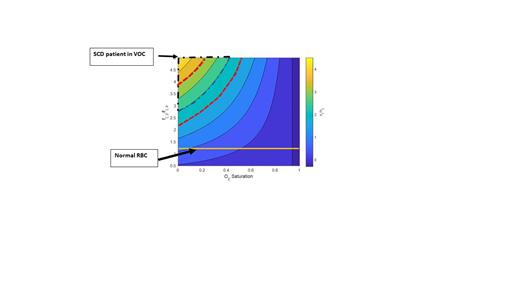Introduction: Patients with sickle cell disease (SCD) can experience intermittent episodes of vaso-occlusive episodes (VOE) leading to acute pain. Additionally, patients can experience changes in pain over their lifetime such that they can have nociceptive, neuropathic, and opiate induced hyperalgesia, all contributing to the development of chronic pain. Developing a test that can delineate VOE from steady state and also differentiate it from chronic pain continues to pose an elusive problem in SCD. It not only impacts endpoints in clinical studies, it can pose a significant challenge for the patient in terms of timely clinical diagnosis and treatment of pain.
Cell Tracking Velocimetry, (CTV), tracks cells on a single cell basis in a very high magnetic energy gradient. This instrument allows us to use the cell's magnetic, v x, and settling velocities, v y, to be transformed into estimates of the oxygen saturation and deformity of the red blood cells, (RBCs). Based on statistical correlations of these measurements to patient status, VOE can be independently identified.
Results: Patients were consented in a single center Institutional Review Board, (IRB) approved study. Clinical data including genotype of the patients were collected in 5 clinical states, including healthy donors (0). Steady State no chronic pain ≤ 3 crisis/year (1), Steady state with chronic pain 3 ≤ crisis/year (2), Steady state with no chronic pain > 3 crisis/year (3), Steady state with chronic pain > 3 crisis/year (4), and during acute pain crisis (5). Steady state was defined as no VOC requiring health care intervention for > 4 weeks and no VOE crisis on day of clinic. The patients' samples (n=49; distributed between each state) and clinical state was deidentified for initial laboratory evaluation. The CTV instruments returns two types of data: magnetic velocity and settling velocity. It was demonstrated that the range of the magnetic velocity of the top and bottom 1 percent of the measured velocities (i.e the fastest and slowest moving RBCs) correlates to a patient in VOE, when compared to normal, healthy RBCs and SCD patients in steady state (p > 0.0168). Further, the ratio of the magnetic to settling velocity of the top and bottom 1 percent of these ratios correlates to a patient in VOE, when compared to normal RBCs and SCD patients in steady state (p > 0.0003). These correlations are significant for both RBCs under deoxygenated and ambient air conditions.
Discussion: We suggest that these correlations have physical significance since further mathematical modeling of these experimental velocities can be reduced to two factors: a shape factor, fe-x/fe-y, (velocities are proportional to the effective diameter of the cells) and the oxygen-hemoglobin saturation of the RBCs. This ratio of this shape factor can be considered as a measure of how “deformed” the RBC is, while the degree of oxygen-hemoglobin saturation is consistent with the traditional oxygen saturation measurement.
Conclusion: While further studies on a larger patient population are warranted, these data suggests that the CTV instrument could potentially provide a biological point of care test to help diagnose VOE. Furthermore, this seems to delineate chronic pain and steady state from acute VOE. A longitudinal study in a consistent patient population would help further delineate and refine this for the specific patient but may offer significant insight over time to correlate the clinical phenotype with a laboratory correlation.
Disclosures
Desai:POC Detection of Hemoglobin Sickling via Magnetic Fractionation: Patents & Royalties: (Pending); US Food & Drug Administration: Research Funding; University of Tennessee: Research Funding; University of Pittsburgh: Research Funding; PCORI: Research Funding; NIH: Research Funding; Novartis: Research Funding, Speakers Bureau; Chiesi: Consultancy; Vertex: Consultancy; Forma Therapeutics: Consultancy.


This feature is available to Subscribers Only
Sign In or Create an Account Close Modal